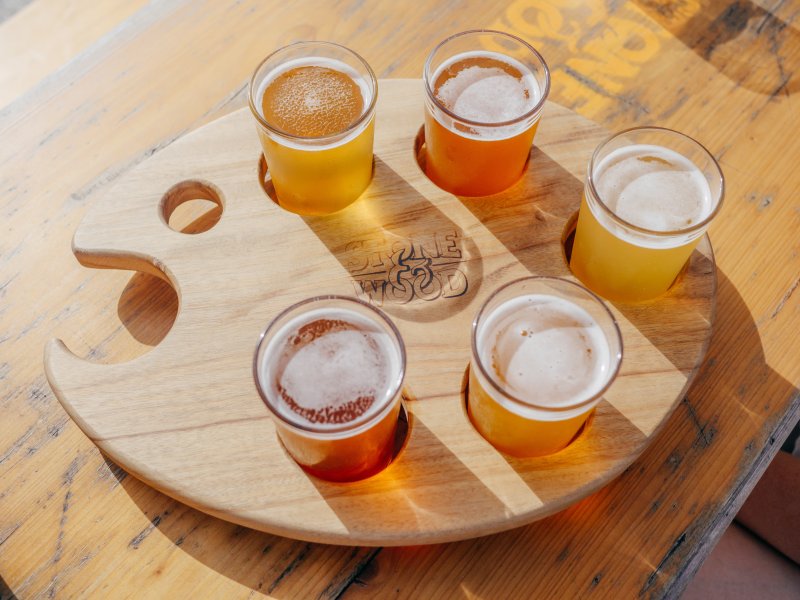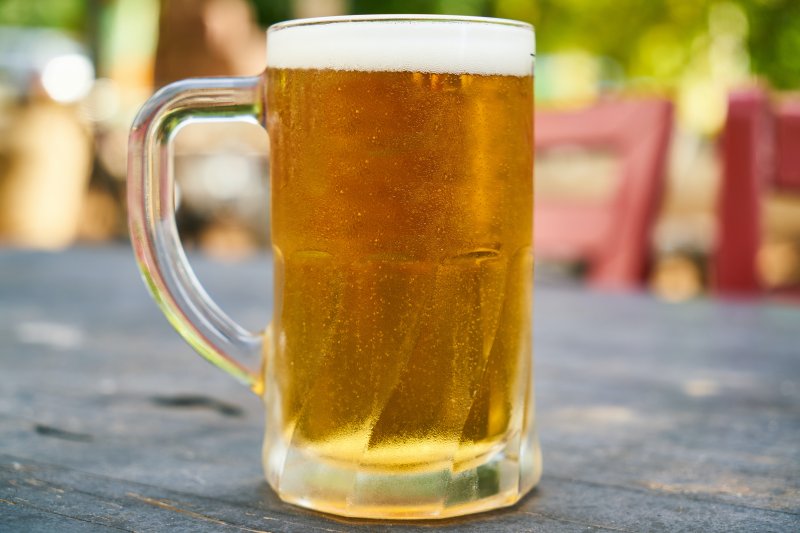Filter Search
Show available only
Categories
Price
Select all
Clear all
$0 - $10
$10 - $50
$50 - $100
$100 - $500
$500 & above
Filter Search
Show available only
Categories
Price
Select all
Clear all
$0 - $10
$10 - $50
$50 - $100
$100 - $500
$500 & above
Product is not availabe in this category, please select other category
ALL ABOUT ALE
Ales and lagers differ quite a bit in taste and appearance from beer to beer. The main difference between the two lies in the fermenting process and ingredients. Historically, brewers produced ales much earlier than lagers due to temperature requirements. Originally, brewers fermented ales with top-fermenting yeast at warm temperatures from about sixty to seventy degrees fahrenheit and only used yeast, water, and malt. Lagers bottom-ferment at colder temperatures from thirty-five to fifty degrees and utilize yeast, water, malt, and hops in their production. Since ales ferment at higher temperatures, they produce results much quicker than lagers, typically taking 3-5 weeks instead of lager’s 6-8 week production window. In modern days, hops have made their way into ales, but in different quantities than lagers require. This adds a bitter quality to a lot of ales since the higher temperatures take on a lot of the bitter qualities of the hops added. Ales also tend to take on higher alcohol content than their counterparts due to increased chemical activity at the higher temperatures. As one of the oldest and most popular types of beer, ales solidified their place in history for many good reasons. One, they don’t require as much time to brew as their lager counterparts, so brewers can craft more beer in less time. Two, they brew at higher temperatures that don’t require as much need for refrigeration, meaning they’ve been crafted for centuries longer and require less energy to produce. Three, they taste delicious! Pick yourself up some of our premium ales and get the party started!

History
Ale’s long history dates back centuries to when it was first brewed as an unhopped beverage made from yeast, malt, and water. Most people in the middle ages drank ale because available drinking water made people sick since it was untreated and carried many unwanted microorganisms that could make people ill. When producing ales, the resulting alcohol content killed off unwanted bacterias. As the ability to create safe drinking water improved, brewers focused more on crafting drinks with higher alcohol contents to enjoy its effects instead of using it to avoid contaminated water. New techniques and ingredients came forward, and ale producers eventually started using bittered hops instead of gruit (a blend of herbs), which had been used historically for bitterness in ales. Since brewers utilize higher temperatures when producing ales, they take on a lot of the bitter taste from the hops, which producers then balance out with other flavors. Modern ales also usually use water rich in calcium sulfate and top-fermenting yeast as well as higher temperatures than those used for lager beers, which gained popularity in the United States for their lighter flavors. Nowadays, many different types of ales exist such as stouts, pale ales, brown ales, strong ales, and dark ales. Take a look at our inventory to find the right ale for you!
How Ale is Made
The brewing process for ale differs from that of lagers or pilsners due to temperature and fermentation styles. It begins with malting barley grains by steeping them in water before allowing them to germinate and then drying them out with hot air during kilning. The next step involves mashing the dried grains (called malt) with hot water so that enzymes break down starches into simple sugars like glucose and fructose, which ferment into alcohol by adding yeast later on in the process. After this comes lautering where more hot water is added before being separated from the grain husks through straining. Finally, brewers boil the mixture and add hops before fermentation starts. The yeast turns the sugary liquid into alcohol over several days or weeks depending on the desired strength of the beer/ale. The resulting fermentation floats on top of the mixture before being strained out. The liquid remaining after this process gets bottled and brought to you!
Types of
- Pale Ale - Pale ales vary from light to medium bodied beers made with pale malts such as Maris Otter or pale ale malt combined with hops for bitterness. Common types include English pale ales (ESB or Extra Special Bitter), American pale ales (APA), India Pale Ales (IPA) and Belgian pale ales. They carry a powerful taste of hops and really light up your taste buds with delicious bitter, pungent flavors that last. Popular brands include Sierra Nevada Pale Ale, Brooklyn East IPA and Three Floyds Alpha King American Pale Ale.
- Brown Ale - Brown ales present as medium bodied beers made with roasted malt for a nutty flavor profile that can range from mild to strong depending on the beer style (e.g., English brown ales vs American Brown Ales). Many love them for their sweet profiles, but brewers actually stopped making these beers in the 18th century, since the paler malts cost less. By the 19th century, producers brought them back again and their resurgence among craft brewers has continued to grow. Popular brands include Newcastle Brown Ale from England and New Glarus Spotted Cow from Wisconsin, USA.
- Strong Ale - Strong ales stand much higher in alcohol content than pale ales and can range from 6% alcohol by volume (ABV) up to 18%. Strong ales tend to carry rich malty flavors with hints of caramel or chocolate. Some examples include barleywine, old ale, imperial stout, and scotch ale. These beers tend to be quite sweet due to their high sugar content and may also have notes of spices or fruitiness depending on the style being brewed.
- Dark Ale - Dark ales typically boast a dark brown in color with a strong roasted malt flavor profiles that range from mild bitterness to intense smokiness. Examples include porter and stout beers which are usually full bodied with low carbonation levels for an added smoothness in texture. Dark ales also may be sweet due to the use of molasses or other sugars during the brewing process.
- Stout - Characterized by their dark color, full body flavor with roasted malt accents, high alcohol content (4 to10% ABV), low carbonation levels and creamy texture due to the presence of nitrogen in the brewing process, stouts present smooth and flavorful. Common types of stouts include Irish dry stout, sweet stout (also known as milk stout or cream stout), oatmeal stout, foreign extra stout, imperial/Russian stout and American double/imperial stout. The most popular brands of stouts include Guinness Draught Stout, Founders Breakfast Stout and Samuel Smith’s Oatmeal Stout.
WHAT DOES ALE TASTE LIKE?
The flavor profile of an ale, ranging from mild and sweet to bitter and hoppy, can vary greatly depending on the ingredients used in the brewing process. Common flavors found in ales include malty sweetness, fruity esters (such as apple or pear), spicy notes (such as clove or pepper), caramel or roasted malt flavors, and hoppy bitterness (which can range from mild to intense).

How to Drink Ale
When it comes to drinking ale properly, consider the aroma, temperature, glass choice, and pouring technique. First off, after opening your bottle of beer take some time to appreciate its aroma before sipping it. Smelling your beer allows you to experience its character more fully before tasting it. Secondly, keep your beer at room temperature or slightly chilled for optimal taste. Lastly, use a clean glassware such as a pint glass or tulip shaped glass if available to help bring out the flavors better than other glasses. Pour your beer slowly down the side of the glass so that it develops a nice head, which helps trap aromas within your drink and makes it even more flavorful.
Popular Ale Styles
Beer aficionados, connoisseurs, and novices alike search for their perfect ale. Liquor Split carries many of these sought-after ales right to your front door. Below are some of our favorite varietals!
- India Pale Ale (IPA) - These signature ales take their stand as one of the most popular choices among beer drinkers worldwide. Most varieties present as bright amber color and carry bold hoppy flavors combined with citrusy undertones to tantalize your taste buds. IPAs provide an intense flavor profile that is both bitter and fruity, which makes a great choice for any beer enthusiast.
- Golden Ale - This light bodied golden colored ale offers crisp hop flavors balanced by biscuit like malts on the palate. The refreshing taste pairs well with most foods or can be enjoyed as an easy to drink summer beer when chilled properly.
- Porter - These dark brown ales carry a full body and robust flavor profile that will delight even the pickiest beer drinker. Many of their complex roasted malt characters provide hints of coffee, chocolate, and nuttiness on the palate. Some porters also may contain hints of smokiness that makes them stand out from other porters on the market.
- English Brown Ale - This style of ale, named after its warm chestnut color, holds a unique title as one of the oldest styles of beer in existence. It features sweet malt flavors balanced by subtle hop bitterness and hints of caramel and nuts on the finish. English Brown Ales perfectly complement the tastes of aficionados looking for an easy drinking ale with a balance between malt sweetness and hop bitterness.
- Imperial Stout - Brewers initially crafted this large format stout in England for export to Russia during colder months. Regular stouts would not survive transport due to freezing temperatures, causing the bottles to explode as the liquid expanded, en route to Moscow! Many imperial stouts feature rich chocolatey notes along with roasted coffee beans, molasses, and raisins on the nose, making them an ideal winter warmer or sipper after dinner treat!
Please select your delivery location for us to get the order deliver faster.
Home
Cart
Profile
Location
